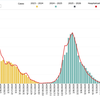School stakeholders must decide on ‘risk tolerance’ in moving to 3-foot distancing
ALBANY COUNTY — On April 9, the state’s health department updated its guidance for distancing at schools, based on recommendations adopted by the Centers for Disease Control and Prevention in March.
The state’s updated guidance says schools, both private and public for pre-kindergarten through 12th grade, must engage with stakeholders, such as students, parents, staff, faculty, unions, and local health departments, to develop a plan to be posted online.
The CDC guidance says that, regardless of community infection rate, elementary students may be seated three feet apart. However, in places with high infection rates, secondary students may sit three feet apart only if they can be isolated in cohorts; otherwise, they must be six feet apart.
The World Health Organization had set the distance at one meter, which is 3.3 feet.
The document released by the state on Friday says, “Ultimately, the school/district’s decision to move to shorter physical distances will come down to a local community’s risk tolerance based on its unique circumstances.”
The state guidance also mandates masks and makes recommendations on ventilation, cleaning, contact tracing, and hygiene.
Since the start of the pandemic, science has evolved on the subject of distancing, initially believing the virus was spread by droplets, which were unlikely to travel beyond six feet, but now believing COVID-19 is largely spread through little, light aerosols, which can spread longer distances.
Also, schools with young children have proven largely to be places where the infection rate is lower than the surrounding community. Children can become infected and transmit the disease but this happens less frequently than transmission to adults, scientists have found.
Schools in Britain, for example, with few restrictions, have had low rates of infection.
In January, the Guilderland schools did surveillance testing of 945 people, including students, faculty, and staff at all seven buildings. Just four of those results were positive.
“I think it’s very encouraging, out of close to 1,000 tests, we had just four positives,” Superintendent Marie Wiles told The Enterprise at the time. “It’s a strong indication school is a safe place to be.”
School districts, like Guilderland, that held in-person classes this school year followed a six-foot distancing rule, which meant all students could not fit in the usual classroom spaces.
At Guilderland, the oldest elementary students were moved to the middle school and the oldest middle-school students were moved to the high school. Guilderland High School students alternated in-person with remote learning.
The hope is that, with three-foot distancing, school buildings can accommodate more students. The Biden administration has been pushing to open elementary and middle schools by the end of the month.
Albany County Executive Daniel McCoy said in March, soon after the new CDC guidance came out, that all the schools in the county except the Albany City Schools already allowed for in-person learning.
New York State United Teachers President Andy Pallotta issued a statement Saturday on the revised guidance, saying, in part: “In adopting new physical distancing guidelines in line with CDC recommendations, the state is making it crystal clear that distancing is only one part of a layered mitigation strategy ….
“While the state recommends that districts ‘strongly consider’ implementing screening testing, we believe there is zero excuse for all districts not to implement routine testing as soon as possible. The federal government is making hundreds of millions of dollars available to New York schools explicitly for this purpose ...
“Ultimately, if changes to local reopening plans are made, it’s up to local departments of health to enforce state required guidelines. They must do so expeditiously and ensure no district is lax in sticking to a layered mitigation strategy.”
Newest numbers
On Sunday, McCoy reported, in a release, that Albany County has 65 new cases of COVID-19, bringing the county’s tally to 22,970.
Of the new cases, 34 did not have clear sources of infection identified, 25 had close contact with someone infected with the disease, three reported traveling out of state, and three were health-care workers or residents of congregate living settings.
The five-day average for new daily positives has increased to 63.4 from 59.4. There are now 535 active cases in the county, up from 519 on Saturday.
The number of Albany county residents under quarantine increased to 1,175 from 1,129. So far, 73,680 residents have completed quarantine. Of those, 22,435 had tested positive and recovered. That is an increase of 45 recoveries since yesterday.
There were three new hospitalizations overnight and there are 29 county residents hospitalized from the virus — a net decrease of one. There are currently six patients in intensive-care units, down from seven yesterday.
The COVID-19 death toll for Albany County remains at 367.
Albany County, as of Saturday, as a seven-day rolling average, had an infection rate of 2.6 percent, according to the state’s dashboard.
Statewide, the infection rate, also as of Saturday, as a seven-day rolling average, was 3.3 percent.
As of Sunday night, 44.8 percent of Albany County’s 307,117 recents have received at least one dose of vaccine, according to the state’s vaccine tracker. McCoy reported on Sunday morning that 30.7 percent were fully vaccinated.
Statewide, 37.4 percent of New Yorkers have received at least one shot and 24.4 percent have completed a vaccine series.


